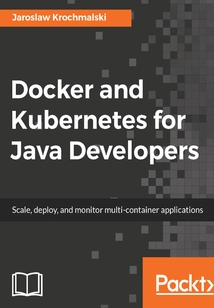舉報 

會員
Docker and Kubernetes for Java Developers
最新章節(jié):
Kube-applier
ThebookisaimedatJavadeveloperswhoareeagertobuild,deploy,andmanageapplicationsveryquicklyusingcontainertechnology.TheyneedhavenoknowledgeofDockerandKubernetes.
目錄(244章)
倒序
- cover
- Title Page
- Copyright
- Docker and Kubernetes for Java Developers
- Credits
- About the Author
- About the Reviewer
- www.PacktPub.com
- Why subscribe?
- Customer Feedback
- Preface
- What this book covers
- What you need for this book
- Who this book is for
- Conventions
- Reader feedback
- Customer support
- Downloading the example code
- Downloading the color images of this book
- Errata
- Piracy
- Questions
- Introduction to Docker
- The idea behind Docker
- Virtualization and containerization compared
- Benefits from using Docker
- Docker concepts - images and containers
- Images
- Layers
- Containers
- Docker registry repository and index
- Additional tools
- Installing Docker
- Installing on macOS
- Installing on Linux
- Installing on Windows
- Summary
- Networking and Persistent Storage
- Networking
- Docker network types
- Bridge
- Host
- None
- Networking commands
- Creating and inspecting a network
- Connecting a container to the network
- Exposing ports and mapping ports
- Persistent storage
- Volume-related commands
- Creating a volume
- Removing a volume
- Volume drivers
- Summary
- Working with Microservices
- An introduction to microservices
- Monolithic versus microservices
- The monolithic architecture
- The microservices architecture
- Maintaining data consistency
- The Docker role
- Kubernetes' role
- When to use the microservice architecture
- Summary
- Creating Java Microservices
- Introduction to REST
- HTTP methods
- REST in Java
- Java EE7 - JAX-RS with Jersey
- JAX-RS annotations
- Spring Boot
- Coding the Spring Boot microservice
- Maven build file
- Application entry point
- Domain model and a repository
- REST controller
- Documenting the API
- Running the application
- Making calls
- Spring RestTemplate
- HTTPie
- Postman
- Paw for Mac
- Spring Initializr
- Summary
- Creating Images with Java Applications
- Dockerfile
- Dockerfile instructions
- FROM
- MAINTAINER
- WORKDIR
- ADD
- COPY
- RUN
- CMD
- The ENTRYPOINT
- EXPOSE
- VOLUME
- LABEL
- ENV
- USER
- ARG
- ONBUILD
- STOPSIGNAL
- HEALTHCHECK
- Creating an image using Maven
- Building the image
- Creating and removing volumes
- Summary
- Running Containers with Java Applications
- Starting and stopping containers
- Starting
- Stopping
- Listing the running containers
- Removing the containers
- Container running modes
- Foreground
- Detached
- Attaching to running containers
- Monitoring containers
- Viewing logs
- Inspecting a container
- Statistics
- Container events
- Restart policies
- no
- always
- on-failure
- unless-stopped
- Updating a restart policy on a running container
- Runtime constraints on resources
- Memory
- Processors
- Updating constraints on a running container
- Running with Maven
- Plugin configuration
- Starting and stopping containers
- Summary
- Introduction to Kubernetes
- Why do we need Kubernetes?
- Basic Kubernetes concepts
- Pods
- ReplicaSets
- Deployment
- Services
- kube-dns
- Namespace
- Nodes
- Kubelet
- Proxy
- Docker
- The Master node
- etcd
- The API server
- The scheduler
- Available tools
- kubectl
- Dashboard
- Minikube
- Summary
- Using Kubernetes with Java
- Installing Minikube
- Installing on Mac
- Installing on Windows
- Installing on Linux
- Starting up the local Kubernetes cluster
- Installing kubectl
- Installing on Mac
- Installing on Windows
- Installing on Linux
- Deploying on the Kubernetes cluster
- Creating a service
- Creating a deployment
- Interacting with containers and viewing logs
- Scaling manually
- Autoscaling
- Viewing cluster events
- Using the Kubernetes dashboard
- Minikube addons
- Cleaning up
- Summary
- Working with the Kubernetes API
- API versioning
- Alpha
- Beta
- Stable
- Authentication
- HTTP basic auth
- Static token file
- Client certificates
- OpenID
- Authorization
- Attribute-based access control
- Role-based access control (RBAC)
- WebHook
- AlwaysDeny
- AlwaysAllow
- Admission control
- Using the API
- API operations
- Example calls
- Creating a service using the API
- Creating a deployment using the API
- Deleting a service and deployment
- Swagger docs
- Summary
- Deploying Java on Kubernetes in the Cloud
- Benefits of using the cloud Docker and Kubernetes
- Installing the tools
- Python and PIP
- AWS command-line tools
- Kops
- jq
- Configuring Amazon AWS
- Creating an administrative user
- Creating a user for kops
- Creating the cluster
- DNS settings
- Root domain on AWS hosted domain
- The subdomain of the domain hosted on AWS
- Route 53 for a domain purchased with another registrar
- Subdomain for cluster in AWS Route 53 the domain elsewhere
- Checking the zones' availability
- Creating the storage
- Creating a cluster
- Starting up clusters
- Updating a cluster
- Installing the dashboard
- Summary
- More Resources
- Docker
- Awesome Docker
- Blogs
- Interactive tutorials
- Kubernetes
- Awesome Kubernetes
- Tutorials
- Blogs
- Extensions
- Tools
- Rancher
- Helm and charts
- Kompose
- Kubetop
- Kube-applier 更新時間:2021-07-02 18:45:33
推薦閱讀
- 手機安全和可信應(yīng)用開發(fā)指南:TrustZone與OP-TEE技術(shù)詳解
- Advanced Quantitative Finance with C++
- JSP網(wǎng)絡(luò)編程(學(xué)習(xí)筆記)
- Web開發(fā)的貴族:ASP.NET 3.5+SQL Server 2008
- INSTANT MinGW Starter
- 機器人Python青少年編程開發(fā)實例
- Advanced Express Web Application Development
- 軟件測試教程
- HTML+CSS+JavaScript網(wǎng)頁設(shè)計從入門到精通 (清華社"視頻大講堂"大系·網(wǎng)絡(luò)開發(fā)視頻大講堂)
- Vue.js 3應(yīng)用開發(fā)與核心源碼解析
- Oracle 12c從入門到精通(視頻教學(xué)超值版)
- Tableau Dashboard Cookbook
- 輕松學(xué)Scratch 3.0 少兒編程(全彩)
- R統(tǒng)計應(yīng)用開發(fā)實戰(zhàn)
- 編譯原理學(xué)習(xí)與實踐指導(dǎo)
- 算法(第4版)
- 算法學(xué)習(xí)與應(yīng)用從入門到精通
- Real-time Web Application Development using Vert.x 2.0
- ASP.NET開發(fā)技巧精講
- Instant OpenCV for iOS
- iOS Application Development with OpenCV 3
- Spring 5.0 Cookbook
- Django By Example
- 自然語言處理實戰(zhàn):從入門到項目實踐
- Learning NServiceBus Sagas
- PHP+MySQL動態(tài)網(wǎng)頁設(shè)計
- JavaScript和jQuery實戰(zhàn)手冊(原書第2版)
- ThinkPHP實戰(zhàn)
- 大模型應(yīng)用開發(fā)極簡入門:基于GPT-4和ChatGPT
- Android移動開發(fā)項目式教程(第2版)

